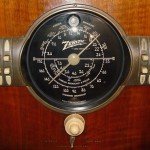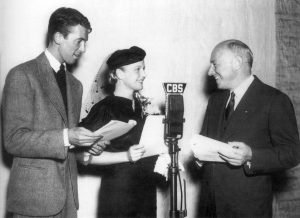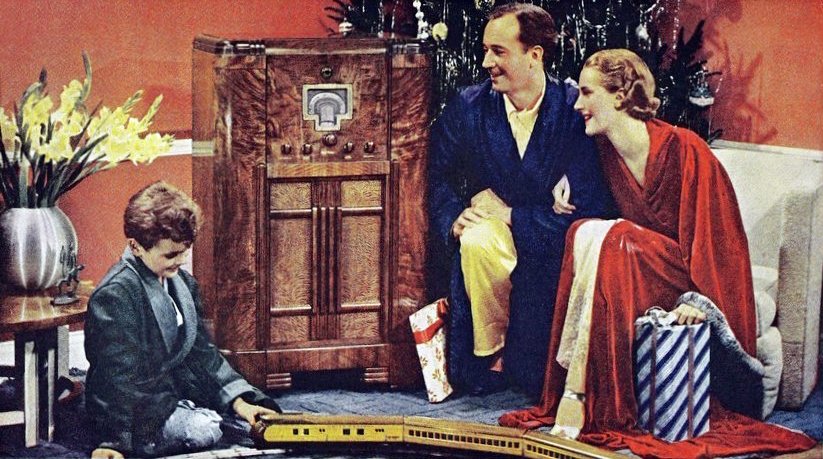
Imagine for a moment an American family collected in a cozy living room and gathered close for the evening’s entertainment. But instead of gazing expectantly at some oversized TV screen while battling the constant distraction of smart phones and mobile devices, the family hovers around the carved, wooden face of a console radio that broadcasts the latest news, stories from the War, and of course, serial radio dramas. This was exactly the sort of evening my father would have enjoyed in the 1940’s.
Just recently, at a dinner party with friends, I spoke with a nonagenarian – a woman simply called The Chief — about the theatrical debut of The Wizard of Oz in 1939. She had been a teenager when the film opened in theaters, and while she sat recollecting the past to dinner guests, her eyes grew wistful and a smile crept across her lips. It’s a facial expression I’m particularly fond of, and it reminded me so much of my dad that I couldn’t help but tell The Chief how my father had grown up listening to old time radio programs. I mentioned that his favorites were The Shadow and Gang Busters, and instantly, The Chief and I were in our own social bubble talking about forgotten shows like Fibber McGee and Molly, George Burns & Gracie Allen, and the Lux Radio Theatre. The rest of the guests watched the exchange and wondered how I, a forty-two year old man, knew so much about radio shows from the 1930’s and 1940’s.
I’d been inspired by my dad’s own childhood stories, and a decade ago, I’d started exploring OTR (Old Time Radio) shows and discovered an endless trove of long-forgotten radio gold. I’ve been collecting shows in digital format from Internet archives ever since; recordings of these old shows, originally broadcast live, are available for free as mp3 downloads from special interest websites. The quality of the recordings is typically poor, but the vast number of audio shows available is truly awe-inspiring. And OTR is more than just drama: it also encompasses comedy, suspense, satire and musical variety shows.
My entrée into golden-age radio began with the aforementioned, serialized thriller, The Shadow. The show’s principal character, voiced for a short time by Orson Welles, is a vigilante detective with the uncanny power to cloud the minds of others and shroud his presence from their sight; though he is never truly invisible, he is still able to pursue his quarry unseen. In the public eye, the hero is a young man about town, Lamont Cranston, who woos his romantic interest, the socialite Margo Lane. But when need arises, he dons the mantle of his alternate identity, The Shadow, to stalk petty criminals and observe them unawares. At the show’s climax, he typically confronts the villains as a disembodied voice to unnerve them and extract a confession of their crime. Just hearing the famous opening phrase “Who knows what evil lurks in the hearts of men? The Shadow knows!” was enough to get me hooked.
In addition to the suspense/thriller genre, I also enjoy radio comedy programs, and the George Burns & Gracie Allen Show has become my leading favorite. The radio show grew from the vaudeville career of two rising stars of the 1920’s: a young Jewish singer, George Burns, who teamed up with a Catholic, vaudeville dancer, Gracie Allen, to form a comedic stage duo. Burns played the straight guy to Allen’s ditzy antics, and the pair, portrayed as singles in the 1920’s and 1930’s, had been married in real life and finally hit peak radio fame in the 1940’s. Their radio act had started to grow stale, but in the fall of 1941, it was reworked to present them as a married entertainment couple. Allen’s nonsensical humor in the 1940’s sketches endures as a perfect foil to husband-knows-best Burns, and the duo eventually transitioned from radio to television and film.
Another great radio comedian of the era is Red Skelton. Skelton is probably remembered more for his television career, but in the 1940’s he created and portrayed a whole cast of characters for various radio shows that enjoyed enduring fame across America. Even today, people unfamiliar with Skelton’s work might at least have heard references to his work or imitations of him in contemporary media. Out of all his sketches, I like best the character of Mrs. Fussy — voiced by Skelton’s costar, Verna Felton. Felton played a cantankerous neighbor that showed up at Red’s house only to blast him with abusive diatribes. Skelton usually had the last word, but the biting one-liners and comebacks between the pair were delivered so fast and furiously as to leave you dizzy.
Red: “Mrs. Fussy, have you ever noticed you have a slight impediment in your speech?”
Mrs. Fussy: “I have?”
Red: “Yes… every once in a while you stop and breathe.”
I also enjoy the language of the period, now fading out of memory, and have rediscovered phrases like “flip your wig”, “doll crazy”, and my favorite “gee, that’d be swell” (which to me sounds horribly contrived but is always delivered with such sincerity that I do a double take). Another aspect of OTR shows that has grown on me is how the writing reflects the moral and social values of an America unfamiliar to me yet simultaneously part of my cultural heritage. Undoubtedly, contemporary listeners would find many OTR stories patently offensive. Racial minorities — non-Caucasian characters — are often voiced by whites and are typically cast as shallow, two-dimensional caricatures of popular stereotypes. And nothing could drive home sexual inequality quite like hearing several Lux Radio Theatre productions from the 1930’s.

The Lux Radio Theatre, hosted for a time by famed Hollywood producer Cecil DeMille, aired live, weekly radio dramas and featured film celebrities in abridged versions of popular stage productions. A common theme in these dramas was the plight of unmarried woman struggling with poverty, and the best solution for a dame in financial trouble was to get hitched to a wealthy man by working diligently and remaining an inscrutable, moral paragon. This plot device occurs so frequently in OTR dramas that you begin to pity the female characters; the fact that they have little personal power other than to seduce men is an indication of the status of women’s rights at the time.
Along with the language and stories of OTR, I find myself equally charmed by the cloying advertisements from the various shows’ sponsors. Yes, I even like the commercials! Almost every serialized show features a recurring sponsor, and sometimes the voice actors themselves read the sponsor’s message or give a personal testimony. I find the tone and delivery of the radio advertisements remarkable in how different it is from modern advertisements. Whereas a commercial today might try to convince me that I can only live a meaningful life if I am twenty or thirty-something and own some innovative, stylish, new car, the ads I hear at breaks during The Shadow warmly address the audience as “friends” and assure me that a smart man like myself will be heating my home with blue, anthracite coal during the winter. These ads, liberated from the clutter of computer-generated images and blazing special effects, have a bare-bones intimacy that evokes the frankness of a door-to-door salesperson.
In fact, I believe this absence of visual imagery is the greatest strength of these long-lost radio shows. Without a flickering screen to stare at, my mind is forced to imagine on its own the appearance of the characters and settings in which their stories take place. The audio effects that populate OTR shows are in themselves a magic act: somehow a handful of Foley artists flesh out a scene with just a few, key sounds produced in a studio. And I’m sure that as I listen to the 1946 episode of Suspense titled The Hunting Trip, I must be visualizing Vincent Price in my own, entirely unique way. Since I lack familiarity with the actors from the era, their disembodied voices appear in my mind as people I have encountered before, and in that way, the stories draw out my own emotions.
It’s difficult for me to conceive how a modern family could enjoy an audio-only radio program and not complain about the absence of a TV screen, and I often wonder what it was like for my dad’s family to gather around the radio; my grandmother would likely have been sewing or knitting and my grandfather, home from the War, sipping some potent libation, but the whole family would’ve been lost in imagination while listening to each week’s new episodes of adventure, suspense, and comedy. Although many OTR programs remain enshrined in the ether of the Internet, fewer and fewer people survive that can recall a time when they were broadcast live over the radio airwaves. I feel fortunate indeed to have stumbled onto this golden trove of Americana, and I hope that many more people will discover the vintage allure of Old Time Radio shows.
Spriggan Radfae

Share this post with your friends.
